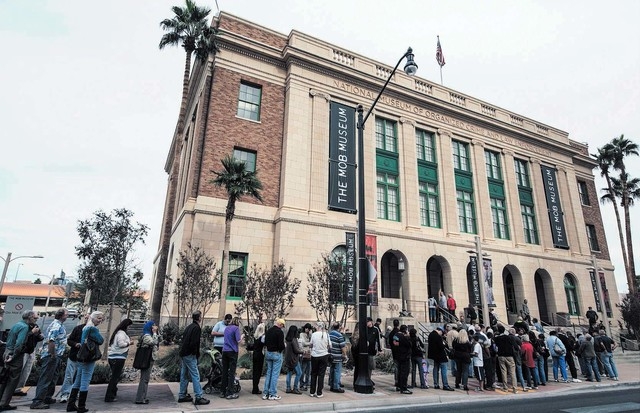Goodman’s Mob Museum gamble paying off

The Mob Museum is no boondoggle.
The museum is about to celebrate it’s second anniversary on Valentine’s Day, and I must give it kudos for its programming, which has attracted me this past year. The program featuring three former governors — Bob List, Richard Bryan and Bob Miller — was a winner. So was the one featuring mob regulator Jeff Silver, mob prosecutor Stan Hunterton and mob chaser George Knapp.
The program I am eager to see next is on Feb. 19, when Elaine Wynn, Jan Jones Blackhurst and Patty Becker are questioned by Marybel Batjer about the role of women in gaming. All four are high fliers whose names are probably already familiar to you.
Wynn is a philanthropist formerly married to what’s his name. Blackhurst is a former Las Vegas mayor, now with Caesars Entertainment. Becker is the first woman on the Gaming Control Board. Batjer has an extensive resume in politics and gaming. All four are smart, savvy and sharp and will likely speak their minds plainly.
Their program kicks off a new approach by the museum, which is embracing an effort to broaden accessibility to the “Courtroom Conversations” in the museum’s beautifully restored courtroom, which only seats 130.
This broader outreach for “Women in Gaming” includes the live event within the courtroom itself where tickets run $125 and $40. Further information is on the website at www.themobmuseum.org.
Then there is an invitation-only event hosted by and at the Mob Bar for Global Gaming Women, a subgroup of the American Gaming Association.
But folks who relish freebies are not forgotten.
The panel discussion will be streamed live on the website.
It will also be shown at the UNLV Student Union starting at 6:30 p.m., courtesy of the UNLV Womens’ Research Institute. (Tickets are free but you must reserve one of the 150 seats by calling 702-895-4931.)
VegasPBS will tape it and broadcast it in May, doubtlessly reaching the largest audience.
The intimacy of the courtroom makes it a unique venue, especially if your imagination sees the ghosts of those who practiced law there starting in 1934 or were involved in the Kefauver hearings on organized crime in 1950.
Museum director Jonathan Ullman said the decision to make the “Courtroom Conversations” more accessible is part of the transition as the museum grows. “After the critical launch, now we can focus on things like programming. We expanded into special programming pretty heavily last year.”
But since they built it for $42 million in tax dollars, have they come?
Former Mayor Oscar Goodman’s wildly optimistic estimates that the museum would attract 800,000 people a year were toned way, way down to 300,000 a year. It hasn’t met that number, but it’s heading in the right direction.
Ullman said in the two years of operation, there were 223,000 visitors the first year and 225,000 the second. Even though that is only an increase of about 2,000 people, since May 2013 there have been double-digit increases monthly over the previous year. Clearly, the attendance is moving up, and Ullman predicts it will hit 250,000 visitors this year.
Unlike the Springs Preserve, which predicted thousands of tourists would come (although they didn’t) the Mob Museum’s mix is 80 percent tourists and 20 percent locals, about what was estimated. “We benefit from a constant influx of tourists,” Ullman said.
Expanding access via the Internet has the potential to reach people interested in the subject, whether they are local, national or international, he said.
Key players in broadening the access included consultant Barbara Molasky, who organized multiple access points through her connections with PBS and the Womens’ Research Institute, along with helpful advice from mob museum board member former Sen. Richard Bryan.
The museum will benefit more when a planned commercial project, which will have a shared plaza with the museum, improves the area north of the Third Street corridor near the Downtown Grand.
Initially I had issues with what was missing from the museum rather than what was included. But after two years of operation, and hearing from plenty of people, including friends, who loved their experience there, I’ve concluded it’s not a $42 million boondoggle.
The museum is making a profit, Ullman said.
Soon it will repay the city $1.5 million as part of a historic tax credit, the first installment of a $6.2 million payment over five years. Another $400,000 for operational costs also is going back to the city. The city’s investment was $37 million, the rest came from state and federal money.
Goodman’s crazy idea he announced in 2002 has proved itself a smart one, well-executed, well-operated and profitable.
Jane Ann Morrison’s column appears Monday, Thursday and Saturday. Email her at Jane@reviewjournal.com or call her at (702) 383-0275.